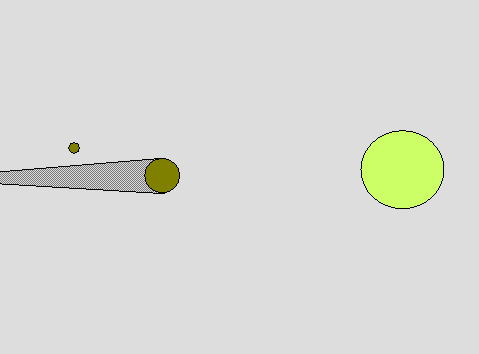
 |
An interesting issue was posed by Aristarchus (who lived about 280 B. C.). He attempted to measure the relative distances of the sun and moon by observing the angle between sun and moon when the moon is exactly half illuminated by the sun. He estimated the relative sizes of Earth and Moon from the shape of the shadow of the earth during lunar eclipses. Combining these results, he found that the sun was at least 300 times bigger in volume than the earth. Two centuries later, Posidonius made a new measurement of the size of the sun, finding it to be several thousand times the volume of the earth.(illustration by G. Rieke) |
If the sun were so much larger than the earth, Aristarchus argued that it was likely to lie at the center of the planetary system, with the earth orbiting it. He appreciated the issue of parallax in this system and correctly proposed that the stars are very far away compared with the size of the orbit of the earth: "that the sphere of fixed stars is of such a size that the circle, in which he supposes the earth to move, has the same ratio to the distance of the fixed stars as the center of a sphere has to the surface."
| Aristarchus also determined the distances from the earth to the moon and sun. He used a geometric argument based on how long lunar eclipses last plus his measurement of the relative sizes of the sun and moon to get the relative distances in terms of the sizes of the three bodies. He then applied Eratosthenes' measurement of the size of the earth to get distances in linear units. (animation by G. Rieke) |  |
Despite the supporting observations regarding the size of the sun, Aristarchus' concept was ultimately rejected in favor of keeping the earth at the center of the system. The reasons are not clear. It may have been that the conceptual difficulties with placing the stars so far away and the lack of any feeling of motion were too strong to overcome. A more interesting argument is that, as an astronomer, Aristarchus had little status in seeking underlying causes: astronomers were supposed just to observe and fit the motions of the planets and and it was the job of others, physicists, to find causes. Geminus, a commentator who is thought to have been inspired by the dominating late Greek scientist, Aristotle, stated: "For it is no part of the business of an astronomer to know what is by nature suited to a position of rest, and what sort of bodies are apt to move...But he must go to the physicist for his first principles." (de Santillana, p. 256). Even though his theory was not accepted, Aristarchus' work on the solar system is a model of the scientific approach - a startling new hypothesis that was backed up with observation and clever theory.